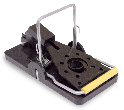Gnats are often called fruit flies, and vice versa. While it's true that gnats and fruit flies are both insects, they are not from the same family of insects. Both are very tiny insects, so it certainly is difficult to tell the difference between the two. And both types of insects are annoying because they are so small and difficult to catch or smack with a fly swatter. The easiest way to discern between the two insects is to think of how you might encounter each in nature.
If you have a bowl of ripening fruit on your kitchen counter, and you notice tiny winged insects flying about, then you have fruit flies in your kitchen, and not gnats. And if you've ever taken a walk on a warm evening and spy a swarm of tiny winged insects up ahead, then you're about to walk into a ghost of gnats. Just as congregating geese are named a gaggle of geese, swarming gnats are named a ghost of gnats. Fruit flies feed off of decaying fruit and the easiest way to rid your home of them is to remove their food source—the fruit. But gnats are really small black flies that feed off of carbon dioxide. The next time you visit a pond with sections of stagnant water, you will see small flies—or gnats—hovering above the water's surface, feeding off of the carbon dioxide exuded by the algae sitting atop the water. The larvae of the gnat feed off of the plant's roots and any organic matter near the soil's surface.
Houseplants can become infested with gnats quite quickly. You won't see any plant damage and, instead, will simply see black gnats buzzing about. Gnats will fly from plant to plant, laying as many as 150 eggs at a time, with the eggs hatching in as little as 3 days. And while a gnat's life lasts less than 8 days, an infestation of gnats is not only destructive to the roots of your houseplants, you'll have the constant annoyance of gnats flying about your home.
At the first sing of gnats flying about your houseplants and home, remove your plants to a sunny location to dry them out. Keep the plants as dry as possible without causing damage. Before watering the plant, place sticky strips of tape or fly traps around the base of all of your plants in order to catch the adult gnats, preventing them from laying eggs in the plant soil. After 8 days, you should notice a severe decrease in the gnat population. If you continue to see gnats, repeat the process of drying your plants and applying sticky traps.

The End of the Road for Mice! Quickly eliminate pesky mice and small rodents with this handy six-pack of traps. Easy to bait, set, use, and release. Unique design catches rodents from the front, sides, and back. Simple, safe, sanitary, and reusable for years. Check out Snap-E Mouse Traps today!
Getting rid of termites is so important that if termites show up in a home inspection, it can potentially threaten the ...
Discover MoreFollow the tips within this article to eliminate earwigs from your home. If you find that you have a large infestation, ...
Discover MoreSometimes confused with lady bugs, carpet beetles differ in that they feed on fibers and carpet of your home, and their ...
Discover MoreThere are currently no comments for this tip. (Be the first to leave your comment—just use the simple form above!)
Copyright © 2025 Sharon Parq Associates, Inc.
Comments